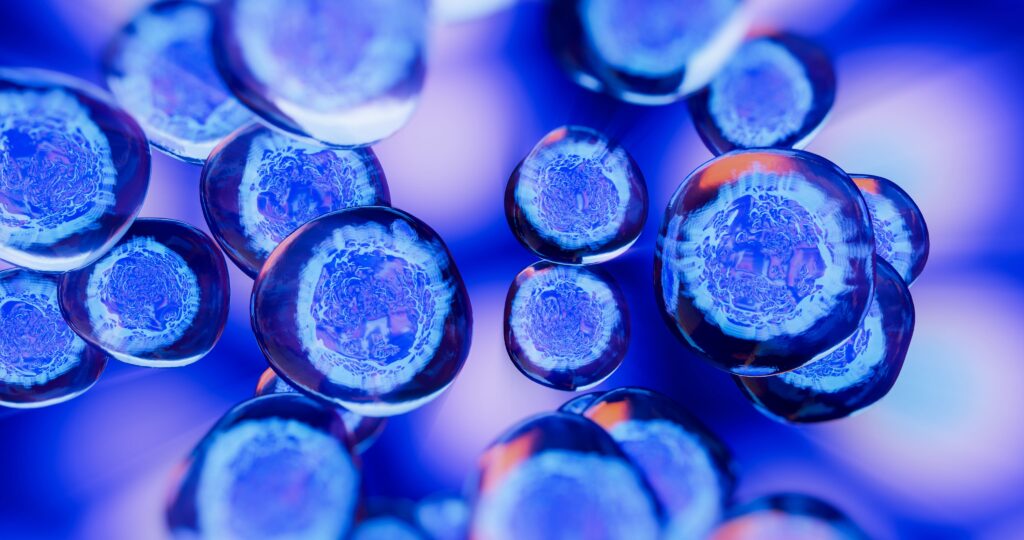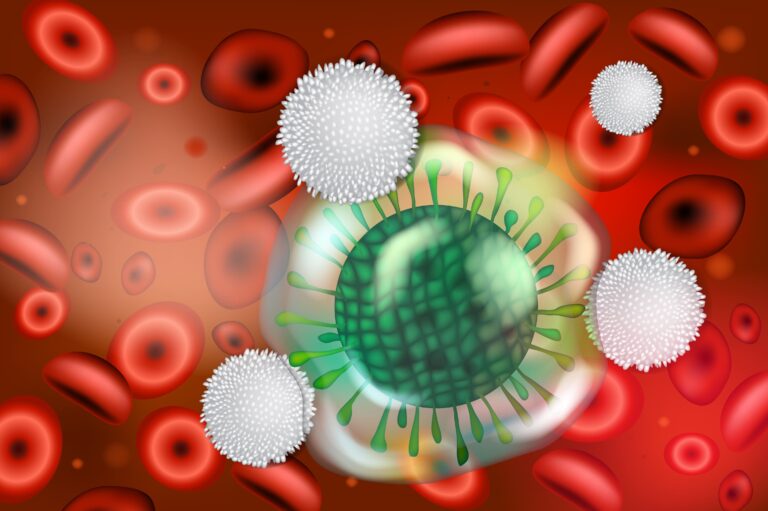A cell is the basic structural and functional unit of life. They are all made up of a cytoplasm enclosed in a membrane, which contains molecules such as nucleic acids and proteins.
There are two main classes of nucleic acids: DNA stands for deoxyribonucleic acid and is a material carrying genetic instructions for the development, functioning, growth and reproduction of all known organisms and many viruses, and RNA which stands for ribonucleic acid and is a molecule essential in various biological roles such as coding, decoding, regulation and expression of genes).
In most cases cell also has a nucleus at its core: it contains all of the cell’s genome (meaning its genetic material or DNA). The nucleus maintains the integrity of genes and controls the activities of the cell by regulating gene expression. As a result, you can consider the nucleus as the control center of the cell.
Cell research is about conceptual or technical advances in the field of molecular and cell biology. This includes research about stem cell biology and development; therefore, this field can answer questions such as “where do stem cells come from?”
Sources of stem cells
Multicellular organisms contain what are known as stem cells. These are undifferentiated (or partially differentiated) cells that can evolve into various types of cells and proliferate indefinitely to produce more of the same stem cell.
What is called “differentiation” is the process by which “similar initial” cells (meaning they are the same in shape and function) can become different cell types with specific functions after dividing – for example: hepatocytes are differentiated cells in the liver. These similar initial cells are the earliest type of cell in a cell lineage.
They are found in both embryonic and adult organisms, but they have slightly different properties in each. All stem cells can develop into at least one mature cell type. Specialised cells however, can only develop into one or a few select cell types.
Various types of stem cells
Throughout life, populations of adult stem cells serve as an internal repair system that generates replacements for cells that are lost through normal wear and tear, injury, or disease. Cells age and thus deteriorate over time, this is called “cellular senescence”: the genetic information contained within cells gets damaged over time, which affects the cell’s ability to maintain its integrity or divide at all.
Senescence can be initiated by external factors but is ultimately unavoidable, except for stem cells. Cells can then die because of internal factors (which is then called “programmed cell death” or PCD), such as apoptosis (the “dissolution” of cells into fragments that can be assimilated before they do damage to surrounding cells); or autophagy (the natural degradation of cells that removes unnecessary or dysfunctional components, such as damaged cells with malformations).
One of the main reasons for ageing is that damaged cells are not destroyed fast enough by autophagy to be replaced. Cell death can also be caused by external factors such as necrosis, a form of cell injury which results in the premature death of cells in living tissue by autolysis (self-digestion).
Multiple studies have also analysed the immune system’s role in regeneration throughout the body.
For instance, there are specialised cells in the bone marrow that can only create blood cells, they are needed to constantly replace old or damaged ones. Those cells are called hematopoietic stem cells (or HSCs); they serve as the “parent” for all of these different types of cells.
HSCs can be transplanted into a person with cancer to help replenish bone marrow (if chemotherapy has destroyed the existing stem cells in their bone marrow). For instance, haematopoietic stem cell transplantation offers a potential cure for haematological malignancies (leukaemia, lymphoma, myeloma) and other haematological disorders such as primary immune deficiency, bone marrow aplasia and myelodysplasia.
Adult stem cells have been identified in many organs and tissues and are generally associated with specific anatomical locations.
There are multiple types of adult stem cells: HSCs, Mesenchymal Stem Cells (the stem cells that can differentiate into bone, cartilage, muscle and fat cells), Neural Stem Cells (neurons and glia), Epithelial Stem Cells (the cells that line our organs) and Skin Stem Cells.
How can we obtain stem cells?
Stem cells can be derived from a human donor (this is the case for most transplants of HSCs), or from human embryos. However, research on human embryos is strictly regulated and has been the subject of multiple coercive laws. It is still subject to high restriction and beforehand authorisation by bioethics institutions.
The first of these embryonic stem cells were grown in a laboratory in 1998 for reproductive purposes. Nowadays they are mostly used for research into treatments or cures (such as in clinical research and trials).
These embryonic cells are called “pluripotent”, which means they can grow into the three types of germ cell layers that make up the human body (ectoderm, mesoderm, endoderm). In other words, they can develop into each of the more than 200 cell types if specified to do so.
Aside from the foetus itself, recent studies have shown that amniotic fluid (the protective liquid serving as a cushion for the growing foetus which also facilitates the exchange of nutrients, water, and biochemical products between it and its mother) contains a considerable quantity of stem cells.
These amniotic stem cells are pluripotent and able to differentiate into various tissues, which may be useful for future research and medical application.
Furthermore, some researchers have found that amniotic fluid is also a plentiful source of non-embryonic stem cells. These cells have demonstrated the ability to differentiate into a number of different cell-types, including brain, liver and bone.
Genetic reprogramming and Induced Pluripotent Stem Cells
Growing cells in a laboratory is known as “cell culture”. Stem cells can develop in a controlled environment, in a culture dish that contains a nutrient broth known as a culture medium (optimised for growing different types of stem cells).
These groups of stem cells cultured in vitro can be propagated indefinitely and are called “stem cell lines”. They are derived from either animal or human tissues and come from one of three sources: embryonic stem cells, adult stem cells, or induced stem cells. After the cells are fully grown, they can be reprogrammed.
Genetic reprogramming is a technique that involves dedifferentiation of adult cells (also known as “somatic cells”) to produce specific Pluripotent Stem Cells (a group of cells that can maintain an undifferentiated state indefinitely and can differentiate into most, if not all, cells of the body), thus eliminating the need for embryos to obtain stem cells in the first place.
These stem cells are called Induced Pluripotent Stem Cells (or iPSCs), since they have been genetically reprogrammed to be more like embryonic stem cells. This reprogramming has been induced through the introduction into the cells of 4 transcription factors (namely Oct3/4, Sox2, KLF4, and c-Myc) which reactivate the expression of genes associated with the embryonic stage. iPSCs usually start out as skin or blood cells which then undergo genetic programming.
They were first developed in 2006 by the Japanese stem cell researcher Shinya Yamanaka, who won the 2012 Nobel Prize in Medicine for this research. iPSCs hold a major advantage over somatic (adult cells donation) and embryonic stem cells: they can be patient-matched. That means a laboratory can customise these cells to make them more adapted to a person’s own cells or tissues, for example using the patient’s own cells directly from a simple skin biopsy.
What are stem cells used for and why is it important that we know how to create them?
There are many ways in which human stem cells are being used in biomedical research and therapeutics development because of their unique regenerative properties.
First, researchers can use stem cells to learn about human biology and for the development of therapeutics. Understanding how stem cells are working results in crucial information about how diseases arise and suggest new strategies for therapy.
Scientists can create specific “organoids” (small models of organs made from stem cells) or tissue chips to study diseased cells and test drugs with personalised results (since iPSCs can be “personalised” on a patient basis).
On the other hand, stem cells can generate cells and tissues for cell-based therapies, also called tissue engineering. Stem cells can be a renewable source of organs and tissues, as these are in far too short supply for global demand.
Technical obstacles to overcome
However, aside from legal roadblocks for bioethics concerns, significant technical hurdles remain that will likely only be overcome through years of intensive research. For instance, controlling stem cells is complicated. They are also present in limited numbers in the body and difficult to grow in large batches in a laboratory, which would be a necessary step if we want to use them as replacement cells to help treat diseases.
There are also concerns that transplanted cells could “overgrow” like in many cancers, or that the body would reject them, being genetically different from mature tissue. Researchers need to control these risks before moving on to large-scale implementation of this medical technology.
This is part of a field called regenerative medicine: either engineering organs or directly injecting personalised iPSCs (or HSCs in the case of stem-cell therapy for instance) to help patients heal.
Because of these applications, worldwide National Institutes of Health support stem cell research while also enforcing a framework for it.
Ultimately, there are three types of stem cells, depending on where they came from:
- Adult stem cells (living in grown human beings);
- Embryonic stem cells (the cells present in an embryo during days 3-5 following fertilisation and prior to implantation, capable of generating all the specialised tissues that make up the human body);
- Induced pluripotent stem cells (iPSCs, created in a laboratory from a cell line and modified to revert back to “stem cell state”).



